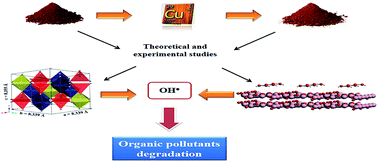Experimental and theoretical study on the reactivity of maghemite doped with Cu2+ in oxidation reactions: structural and thermodynamic properties towards a Fenton catalyst
Abstract
In this work, a polymeric method was used to prepare undoped and Cu-doped iron oxide catalysts for the H2O2 decomposition reaction. These catalysts were characterized by powder X-ray diffractometry (XRD), scanning electronic microscopy (SEM) coupled to an energy dispersive X-ray spectrometer (EDX), and H2-Temperature Programmed Reduction (H2-TPR). The SEM images show an inhomogeneous particle cluster in both samples, tending to decrease in size with Cu-doping. EDX mapping reveals a good dispersion of Cu2+ in the iron oxide. In addition, Rietveld refinement of the XRD patterns reveals that the samples are constituted of hematite and maghemite, but only maghemite has octahedral Fe3+ ions isomorphically replaced by 2 wt% Cu2+. Cu-doping produces an active catalyst for H2O2 decomposition. Tests using phenol show the strong inhibition of H2O2 decomposition by the Cu-doped catalysts, suggesting that H2O2 may be decomposed via a radical mechanism. Furthermore, phenol degradation kinetics confirm that the doping of maghemite with Cu2+ brings about a significant improvement in catalytic activity. Theoretical calculations reveal that Cu-doping in maghemite produces low electronic density sites, favoring the interactions between the surface oxygens of H2O2 and Cu2+, thus improving the catalytic activity. This strategy can be extended to other materials to design active heterogeneous catalysts for environmental purposes.


 Please wait while we load your content...
Please wait while we load your content...